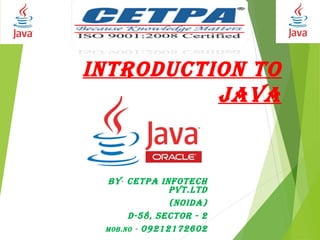
INTRODUCTION TO JAVA
- 1. INTRODUCTION TO JAVA BY- CETPA INFOTECh PVT.lTD (NOIDA) D-58, sECTOR - 2 MOB.NO - 09212172602
- 2. Introduction Present the syntax of Java Introduce the Java API Demonstrate how to build stand-alone Java programs Java applets, which run within browsers e.g. Netscape Example programs
- 3. Why Java? It’s the current “hot” language It’s almost entirely object-oriented It has a vast library of predefined objects and operations It’s more platform independent this makes it great for Web programming It’s more secure It isn’t C++
- 4. Applets, Servlets and Applications An applet is designed to be embedded in a Web page, and run by a browser Applets run in a sandbox with numerous restrictions; for example, they can’t read files and then use the network A servlet is designed to be run by a web server An application is a conventional program
- 5. Building Standalone JAVA Programs (on UNIX) Prepare the file foo.java using an editor Invoke the compiler: javac foo.java This creates foo.class Run the java interpreter: java foo
- 6. Java Virtual Machine The .class files generated by the compiler are not executable binaries so Java combines compilation and interpretation Instead, they contain “byte-codes” to be executed by the Java Virtual Machine other languages have done this, e.g. UCSD Pascal This approach provides platform independence, and greater security
- 7. HelloWorld (standalone) Note that String is built in println is a member function for the System.out class public class HelloWorld { public static void main(String[] args) { System.out.println("Hello World!"); } }
- 8. Comments are almost like C++ /* This kind of comment can span multiple lines */ // This kind is to the end of the line /** * This kind of comment is a special * ‘javadoc’ style comment */
- 9. Primitive data types are like C Main data types are int, double, boolean, char Also have byte, short, long, float boolean has values true and false Declarations look like C, for example, double x, y; int count = 0;
- 10. Expressions are like C Assignment statements mostly look like those in C; you can use =, +=, *= etc. Arithmetic uses the familiar + - * / % Java also has ++ and -- Java has boolean operators && || ! Java has comparisons < <= == != >= > Java does not have pointers or pointer arithmetic
- 11. Control statements are like C if (x < y) smaller = x; if (x < y){ smaller=x;sum += x;} else { smaller = y; sum += y; } while (x < y) { y = y - x; } do { y = y - x; } while (x < y) for (int i = 0; i < max; i++) sum += i; BUT: conditions must be boolean !
- 12. Control statements II Java also introduces the try statement, about which more later switch (n + 1) { case 0: m = n - 1; break; case 1: m = n + 1; case 3: m = m * n; break; default: m = -n; break; }
- 13. Java isn't C! In C, almost everything is in functions In Java, almost everything is in classes There is often only one class per file There must be only one public class per file The file name must be the same as the name of that public class, but with a .java extension
- 14. Java program layout A typical Java file looks like: import java.awt.*; import java.util.*; public class SomethingOrOther { // object definitions go here . . . } This must be in a file named SomethingOrOther.java !
- 15. What is a class? Early languages had only arrays all elements had to be of the same type Then languages introduced structures (called records, or structs) allowed different data types to be grouped Then Abstract Data Types (ADTs) became popular grouped operations along with the data
- 16. So, what is a class? A class consists of a collection of fields, or variables, very much like the named fields of a struct all the operations (called methods) that can be performed on those fields can be instantiated A class describes objects and operations defined on those objects
- 17. Name conventions Java is case-sensitive; maxval, maxVal, and MaxVal are three different names Class names begin with a capital letter All other names begin with a lowercase letter Subsequent words are capitalized: theBigOne Underscores are not used in names These are very strong conventions!
- 18. The class hierarchy Classes are arranged in a hierarchy The root, or topmost, class is Object Every class but Object has at least one superclass A class may have subclasses Each class inherits all the fields and methods of its (possibly numerous) superclasses
- 19. An example of a class class Person { String name; int age; void birthday ( ) { age++; System.out.println (name + ' is now ' + age); } }
- 20. Another example of a class class Driver extends Person { long driversLicenseNumber; Date expirationDate; }
- 21. Creating and using an object Person john; john = new Person ( ); john.name = "John Smith"; john.age = 37; Person mary = new Person ( ); mary.name = "Mary Brown"; mary.age = 33; mary.birthday ( );
- 22. An array is ana object Person mary = new Person ( ); int myArray[ ] = new int[5]; or: int myArray[ ] = {1, 4, 9, 16, 25}; String languages [ ] = {"Prolog", "Java"};
- 23. For more details please contact:- cetpa inFotecH pVt.ltd QUerY@cetpainFotecH.com